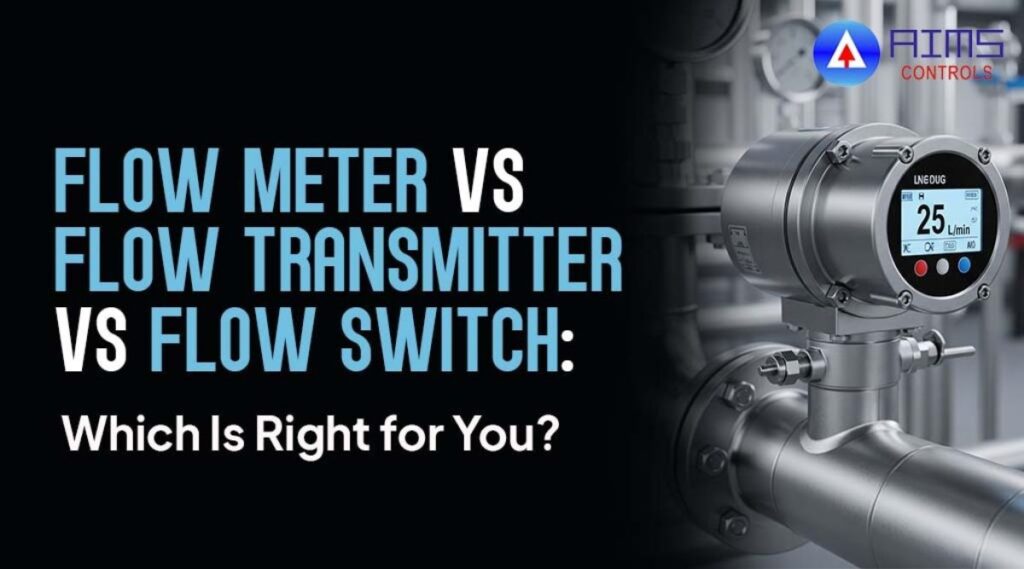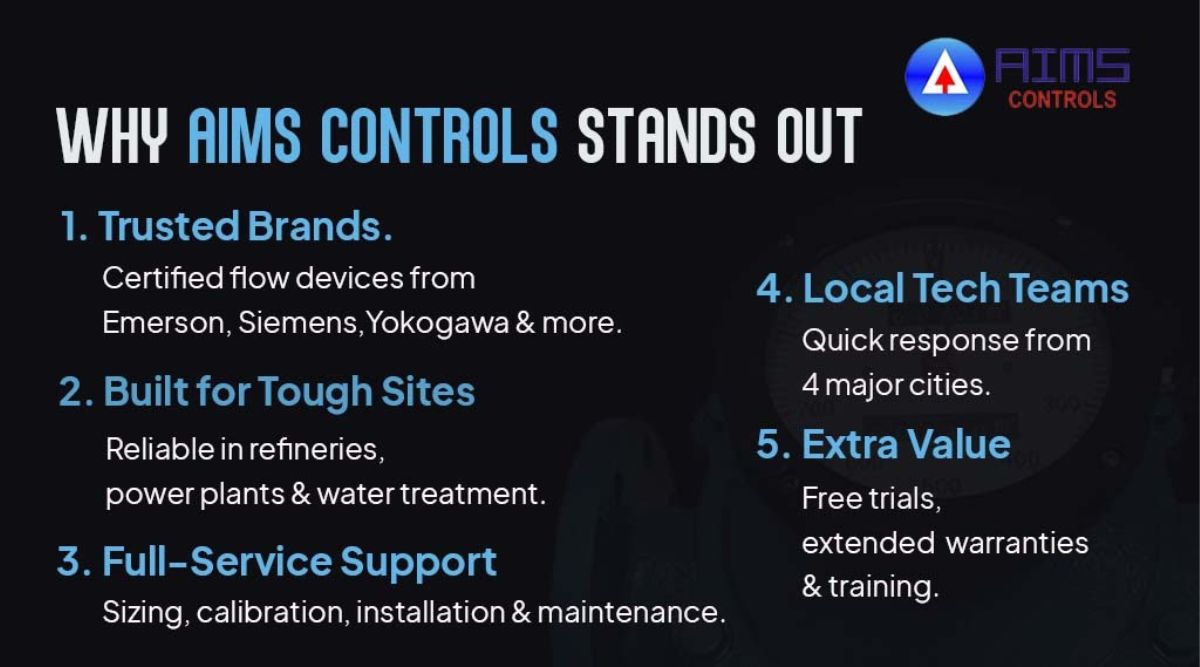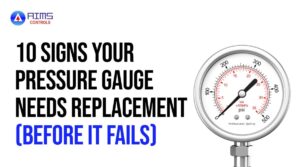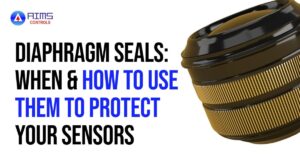Introduction
Precise flow control is the backbone of India’s vital systems—moving crude through coastal refineries, circulating chilled water in glass-clad offices, and dosing chemicals in city wastewater plants.
To keep everything running safely and efficiently, engineers rely on three main instruments: a flow meter to measure how much liquid or gas is passing, a flow transmitter to send that measurement to your control room, and a flow switch to raise an instant alarm if the flow drops or spikes.
Picking the right device for the right job protects equipment, saves energy, and avoids costly downtime. This short guide explains when to use each tool, what they typically cost in the Indian market, and how AIMS Controls can match a solution to your exact process needs.
Get a custom quote tailored to your application below.
What Each Device Does & Why It Matters
What is a Flow Meter?
A flow meter is the primary sensor that tells you how much fluid is moving through a line, litres per minute in a dairy pasteuriser, cubic metres per hour in an oil pipeline, or kilograms per second in a petrochemical cracker. With hard numbers on screen, operators can bill accurately, balance energy loads, and satisfy pollution-control norms.
What is a Flow Transmitter?
A flow transmitter picks up the meter’s raw signal, often a low-voltage pulse or turbine frequency, and converts it into a robust 4–20 mA, HART, or Modbus output for your PLC or SCADA. In an HVAC chiller plant, that signal lets the VFD pump speed track building demand; in a pharmaceutical clean room, it feeds feedback loops that keep solvent flow within ±1 % of the recipe.
What is a Flow Switch?
A flow switch is the watchdog. Set a threshold, say, 10 L/min in a brewery’s CIP line, and the switch trips a relay if flow falls below that point, cutting heaters or firing an SMS alarm. Boiler-feed circuits, water-treatment skids, and sprinkler systems rely on flow switches to protect pumps, prevent overheating, and flag leaks before they become costly downtime.
Flow Meter vs Flow Transmitter vs Flow Switch — Side-by-Side Comparison
| Feature / Use Case | Flow Meter | Flow Transmitter | Flow Switch |
| Function | Measures volume or flow rate directly | Converts flow-meter signal into standard telemetry for remote monitoring or closed-loop control | Provides binary detection (flow / no flow) to trip alarms or interlocks |
| Typical Outputs | Pulse, frequency, analog voltage, local display | 4 – 20 mA, HART, Modbus, Profibus | Dry contact, SPDT relay, transistor open-collector |
| Ideal Applications | Custody transfer, energy billing, recipe dosing, effluent monitoring | SCADA dashboards, PLC feedback, VFD speed control, cloud IIoT gateways | Pump-run confirmation, mag-drive seal protection, boiler heater cut-out, sprinkler verification |
| Price Range (India, ex-works) | ₹25 000 – ₹1.6 lakh (~$300 – 2 000) | ₹17 000 – ₹65 000 (~$200 – 800) | ₹12 000 – ₹40 000 (~$150 – 500) |
| AIMS Strength | In-house calibration rigs and on-site commissioning across refineries, pharma, and breweries | Custom signal scaling, protocol conversion, hazardous-area enclosures | IP67 rugged housings, long-life relays, SIL2 safety approvals |
Many modern skids pair a magnetic or Coriolis flow meter with a smart flow transmitter inside the same panel. That combo lets operators read calibrated litres-per-minute locally while a PLC logs a clean 4 – 20 mA loop—no extra wiring, no guessing.
Contact us for a quote on combined packages at AIMS Controls.
When to Choose Which – Real Industry Scenarios
Industrial Process Monitoring
For continuous production lines—think refinery distillation columns or dairy pasteurisers a flow meter paired with a flow transmitter streams calibrated data straight to PLCs and SCADA dashboards. Operators see live litres-per-minute, while the transmitter’s 4–20 mA loop lets the control system adjust pump speed and temperature in real time.
Simple Pump Safety & Control
If the goal is basic protection, a flow switch is the budget hero. Mount it on a cooling-water return line and set a low-flow threshold; the relay will shut the pump before bearings run dry, saving seals and motors without adding extra I/O cards.
Custody Transfer, Billing, or Chemical Blending
For applications where every drop equals revenue, fuel loading racks, LPG bottling, and pharmaceutical batching—combine a high-accuracy flow meter (Coriolis or ultrasonic) with a smart transmitter. The meter guarantees ±0.1 % accuracy; the transmitter scales pulses to a secure Modbus count for automatic invoicing and recipe control.
Mini Case: Water-Treatment Cost Saver
A municipal plant in Gujarat cut energy costs by 12 % after swapping ageing magnetic meters for differential-pressure flow meters. Teaming each meter with a compact transmitter improved turndown, while an inline flow switch triggered instant pump shutdown during backwash cycles, preventing dry-run damage and trimming maintenance calls by half.
Looking for the right flow solution for your site? Request a quote now.
Why AIMS Controls Is the Ideal Supplier
With decades of experience in India’s flow-instrumentation landscape, AIMS Controls understands the harsh realities of refinery corridors, power-plant boiler rooms, and remote water-treatment sites. We source flow meters, transmitters, and switches from industry leaders such as Emerson, Siemens, Yokogawa, Rosemount, and Endress + Hauser ensuring every device is certified, traceable, and built for long life.
But hardware is only half the story. Our end-to-end services cover:
- Specification advice and sizing
- Factory-certified calibration on NABL-accredited rigs
- On-site installation and loop commissioning
- Preventive maintenance and emergency swap-outs
Local technical teams stationed in Mumbai, Chennai, Ahmedabad, and Hyderabad mean faster call-outs and lower travel costs. Add-on perks, free demo units for critical trials, extended warranties, and hands-on operator training turn one-time purchases into long-term performance gains.
Get your custom pricing—Request a quote from our experts and put decades of field know-how to work on your next project.
Request Your Free Quote Today
Ready to match the right instrument to your process? Fill out our quick quote form with these details:
- Fluid type (water, steam, crude, acids, gases)
- Minimum and maximum flow rate
- Operating pressure and temperature
- Preferred output (pulse, 4–20 mA, Modbus, relay)
- Accuracy or turndown requirements
Our team replies within 24 hours—often sooner—with a tailored shortlist, budgetary pricing, and lead-time estimates. Need extra clarity? A technical engineer follows up to fine-tune specs, arrange a site visit, or schedule an online demo. Flexible payment terms, GST-compliant invoices, and pan-India delivery keep procurement smooth.
FAQs
Q1: What’s the difference between a flow meter and a flow transmitter?
A flow meter is the primary sensor that measures how much fluid is moving, displaying litres per minute, cubic metres per hour, or kilograms per second right at the pipe. A flow transmitter takes that raw reading and converts it into a robust electrical signal (4 – 20 mA, HART, Modbus) so PLCs, SCADA screens, or cloud dashboards can log and control the process in real time.
Q2: Can I use a flow switch without a meter?
Yes. If your application only needs a go/no-go confirmation—such as shutting down a pump when cooling water stops—a standalone flow switch is sufficient. The switch’s relay trips instantly when flow falls below (or rises above) a set point, protecting equipment without the added cost of continuous measurement.
Q3: How do I choose between electromagnetic, ultrasonic, and turbine flow meters?
Selection hinges on four factors: fluid type, pipe size, accuracy target, and budget. Electromagnetic meters excel with conductive liquids like wastewater or acids; ultrasonic units suit large pipes and clean water; turbine meters offer economical accuracy for light oils and solvents. Share your parameters with AIMS Controls, and we’ll recommend the optimal technology for your specific process.
Summary & Next Step
Choosing the right mix of flow meter, flow transmitter, and flow switch ensures your plant hits performance targets while avoiding unnecessary spend. With decades of serving India’s oil & gas, water, HVAC, and chemical sectors, AIMS Controls delivers perfectly matched instruments, plus calibration, installation, and lifetime support. Ready to optimise your flow loop? Get a tailored quote from AIMS Controls today.








